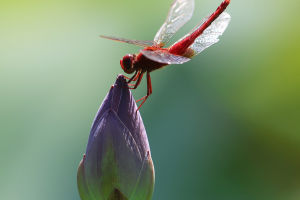Dragonflies are among the oldest insects on Earth, with a history dating back more than 300 million years, making them older than dinosaurs.
These insects are known for their beautiful wings and flexible flying abilities. Especially before it rains, we often notice that dragonflies fly very low, which arouses the curiosity of many people.
So why do dragonflies fly so low before it rains? To solve this mystery, we need to explore the flight principle of dragonflies, the changes in the air before the rain, and the dragonflies' coping strategies.
First of all, understanding the flight principle of dragonflies is the basis for answering this question. Dragonflies have two pairs of wings, each of which can move independently, which enables dragonflies to perform complex flight maneuvers in the air, such as fast turns, inverted flight, and hovering.
The dragonfly's wing structure is very delicate, consisting of tiny blood vessels and muscles, which enable dragonflies to adjust the angle and shape of their wings according to changes in airflow and pressure. Through this precise adjustment, dragonflies can use the power of the air to support their bodies, much like a sophisticated helicopter.
Next, we need to understand how changes in the air before rain impact the flight of dragonflies. Typically, before it rains, the air experiences changes in temperature, humidity, and air pressure. These changes cause the density of the air to increase and the airflow to slow down.
In this environment, the air becomes colder, wetter, and heavier, which makes dragonflies face greater resistance when flying. Dragonflies rely on the power of the air to fly, so when the air becomes denser or the flow slows down, dragonflies will find it difficult to fly, just like swimming in water.
Faced with this challenge, dragonflies have adopted a clever coping strategy: lowering their flight altitude. Dragonflies fly very low because the air near the ground is relatively warmer, drier, and lighter, resulting in lower air density and faster airflow.
In this way, dragonflies can use more air power at a lower altitude to lift themselves, just like flying in the wind. Therefore, when it is about to rain, dragonflies often choose to fly lower, even staying in the grass or on the water.
The phenomenon of dragonflies flying very low before the rain is their adaptive response to the upcoming weather changes. Dragonflies adapt to changes in air density and flow by adjusting their flight altitude to ensure that they can maintain their ability to fly in a changing environment.
This behavior not only reflects the wisdom and survival ability of dragonflies but also gives us a deeper understanding of the complexity and mystery of nature.
The secret of dragonfly flight not only allows us to learn more about the life of this ancient insect but also reminds us to pay attention to those seemingly insignificant but intelligent details in nature.


